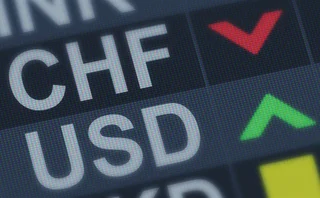
First SOFR swaps trade as banks test new benchmark
First OTC trades include two basis swaps and an OIS trade, with JP Morgan thought to be a counterparty

The first over-the-counter swaps linked to the new US secured overnight financing rate (SOFR) have been traded and cleared at LCH, in a landmark moment for the derivatives market. The trades follow a stark warning from the UK’s Financial Conduct Authority (FCA) that the market needs to speed up preparations for the possible death of the Libor reference rates.
The first trade was a SOFR-versus-Fed-Funds basis swap arranged by TP Icap and executed on its swap execution facility. It printed at 12:57pm New York time on July 16 and had a $50 million notional and one-year maturity, according to information from a swap data repository.
The trade was followed by a SOFR overnight indexed swap at 2:44pm and another SOFR-Fed Funds basis swap at 3:04pm. Both trades also had a notional of $50 million and a one-year maturity, but were executed off-venue.
The three trades were cleared at LCH on the first day its SOFR clearing service became available. It is thought JP Morgan was one of the counterparties to the trades. The bank declined to comment.
Two sources claim they were “pipe cleaner trades” designed to test the waters, but another source close to the trades denied they were tests.
Trading in SOFR swaps continued today (July 17), with BNP Paribas printing a SOFR OIS trade in the interdealer market.
Eric Duclos, head of US dollar flow rates trading at BNP Paribas in New York, says the bank wanted to print a SOFR trade as soon as possible to get comfortable with the process.
“We wanted to make sure we can trade and accommodate our clients’ needs the right way,” he says.
The three SOFR trades used the Fed Funds rate to discount the present value of future cashflows and to calculate interest on posted variation margin, in line with LCH’s previous decision to apply that rate to SOFR swaps in the short term. This approach has annoyed some market participants.
In contrast, CME – which is set to start clearing SOFR products from September, subject to regulatory approvals – will use SOFR for discounting and interest calculation, according to a spokesperson.
The trading and clearing of the first SOFR swaps represent the next stage in the evolution of the fledgling SOFR market. The index started printing a daily rate on April 3, while futures on the rate were launched on CME in early May.
SOFR is a measure of the cost of borrowing cash overnight, collateralised by US Treasuries. It includes tri-party repo trades, general collateral repo and bilateral trades cleared through the Fixed Income Clearing Corporation.
It was selected by the US Alternative Reference Rate Committee – an industry working group convened by the US Federal Reserve – last year as an alternative reference rate to US dollar Libor for interest rate contracts.
Disappearing Libor
In July last year, the UK FCA, which oversees US dollar Libor, said it would give up its power to compel banks to remain on the various Libor panels from the end of 2021, raising fears the rate could disappear at some point after that date.
The Fed is encouraging market participants to put new risk into SOFR swaps instead of US dollar Libor and to switch over their stock of legacy US dollar Libor swaps to reference SOFR, to prepare for Libor’s possible death.
Ice Benchmark Administration, the Libor administrator, is trying to persuade banks to continue submitting quotes to the panels after 2021 voluntarily, and at least two have indicated interest – leading some to believe Libor will survive for years to come.
However, earlier in July, FCA chief executive Andrew Bailey said the regulator would retain the power to pull the plug on a Libor rate after 2021 if there were not enough banks on the panel to provide quotes.
Update: After publication of this story, an LCH press release confirmed JP Morgan was a counterparty to the first trades, along with Goldman Sachs and Credit Suisse.
Editing by Olesya Dmitracova
Only users who have a paid subscription or are part of a corporate subscription are able to print or copy content.
To access these options, along with all other subscription benefits, please contact info@risk.net or view our subscription options here: http://subscriptions.risk.net/subscribe
You are currently unable to print this content. Please contact info@risk.net to find out more.
You are currently unable to copy this content. Please contact info@risk.net to find out more.
Copyright Infopro Digital Limited. All rights reserved.
You may share this content using our article tools. Printing this content is for the sole use of the Authorised User (named subscriber), as outlined in our terms and conditions - https://www.infopro-insight.com/terms-conditions/insight-subscriptions/
If you would like to purchase additional rights please email info@risk.net
Copyright Infopro Digital Limited. All rights reserved.
You may share this content using our article tools. Copying this content is for the sole use of the Authorised User (named subscriber), as outlined in our terms and conditions - https://www.infopro-insight.com/terms-conditions/insight-subscriptions/
If you would like to purchase additional rights please email info@risk.net
More on Markets
Europe’s FXPBs take advantage of margin rule carve-out
Some big FX options users have switched to dealers capitalising on regulatory mismatch
Breaking out of the cells: banks’ long goodbye to spreadsheets
Dealers are cutting back on Excel amid tighter regulation and risk concerns
FXSpotStream looks to growth products beyond spot
New chief exec Jeff Ward highlights NDFs and FX swaps as next boom area for the venue
BNP Paribas targets hedge funds with equity vol carry options
Bank aims to meet demand for QIS options extending beyond commodities
Canada’s triparty repo launch aims to fill C$60bn void
Test trades on TMX/Clearstream platform represent “quantum leap” for creaking funding markets
SG trader dismissals shine spotlight on intraday limit controls
Risk experts say many banks rely on daily reports and can’t effectively monitor intraday limits in real time
Hedge funds’ pricing often trumps other buy-siders – SNB
Research shows “advantageous” prices result in outperformance of 139bp trading USD/CHF
Softer FX rules for China QFIs set to boost CNY competition
Freedom to circumvent local custodians a plus for pricing and best execution – State Street
Most read
- Basel Committee reviewing design of liquidity ratios
- SG trader dismissals shine spotlight on intraday limit controls
- Too soon to say good riddance to banks’ public enemy number one








